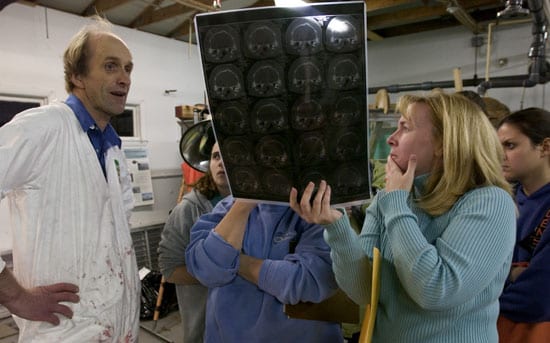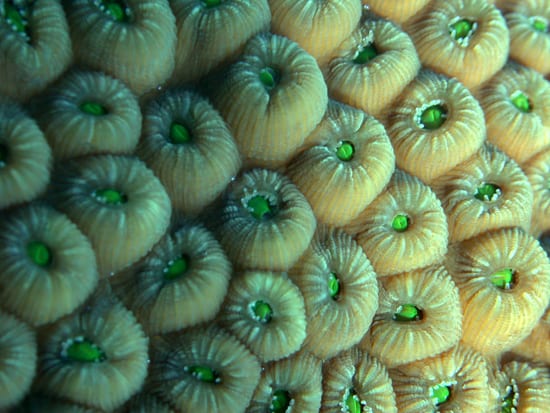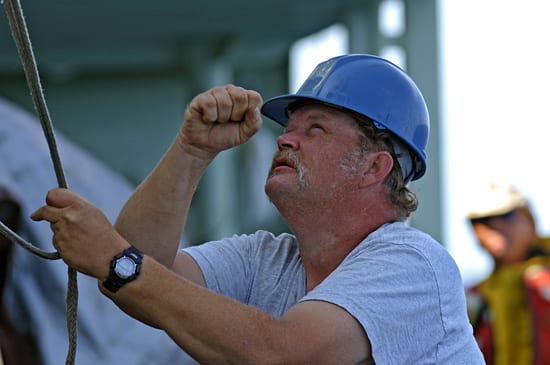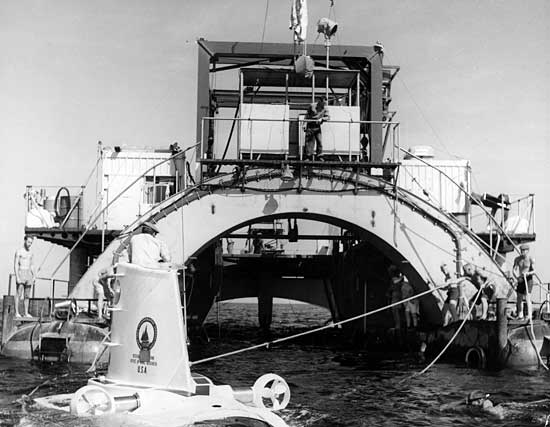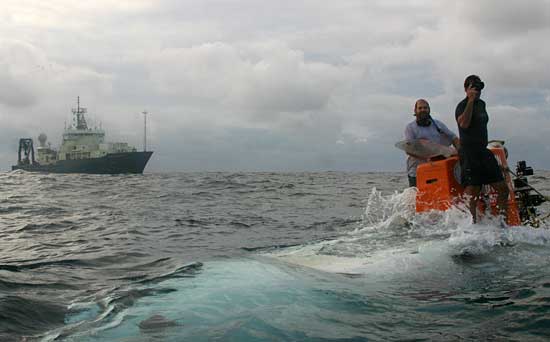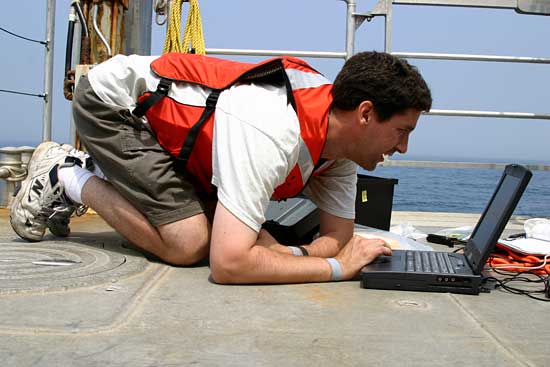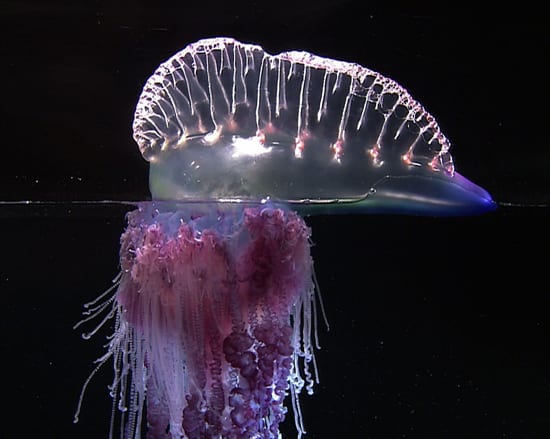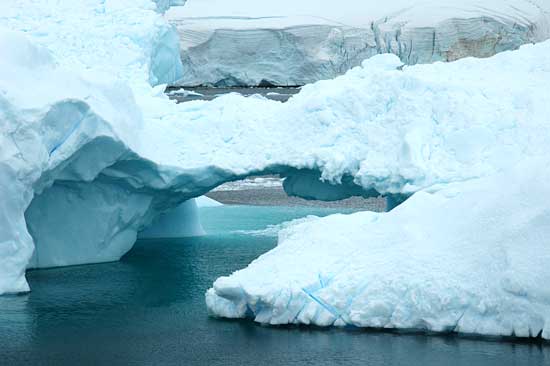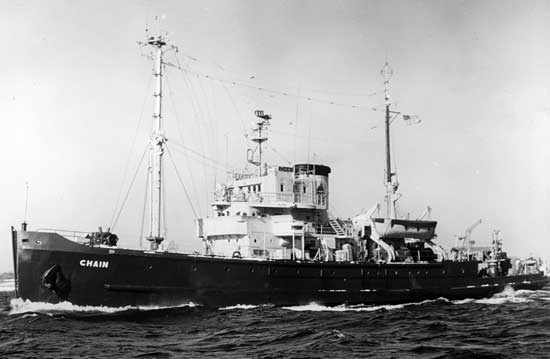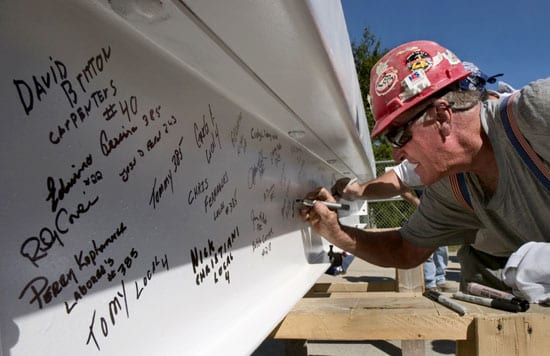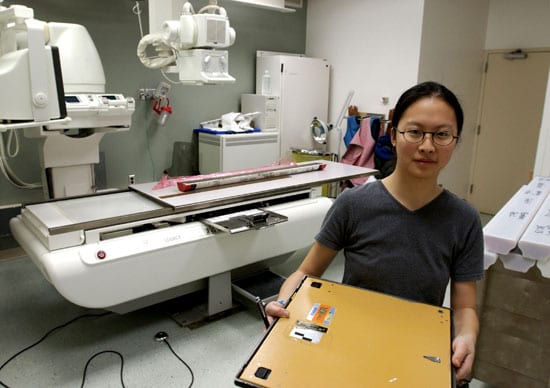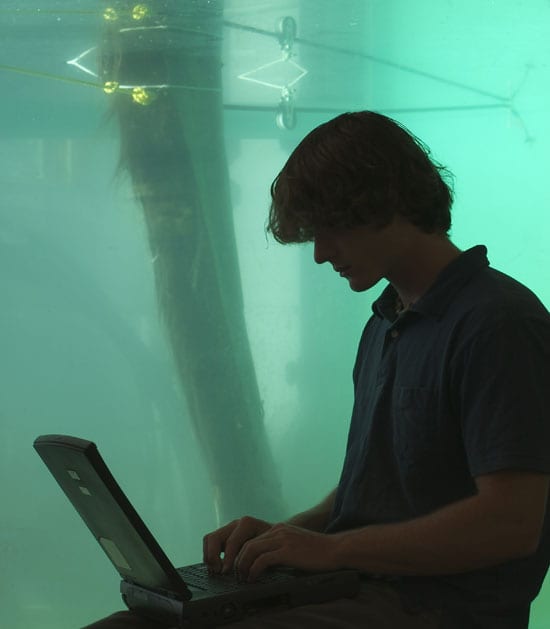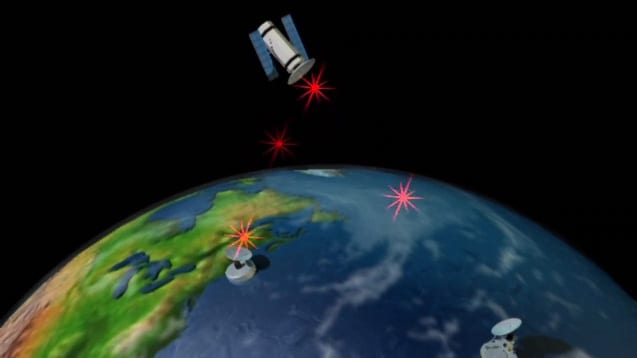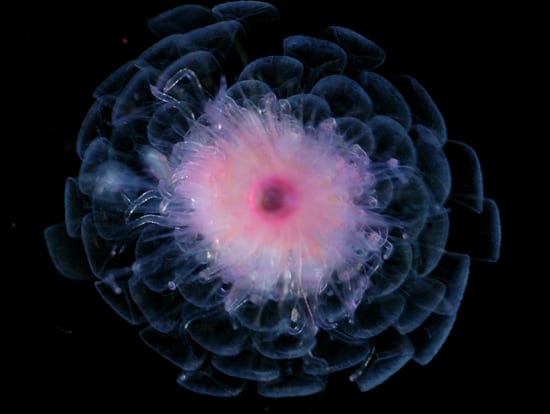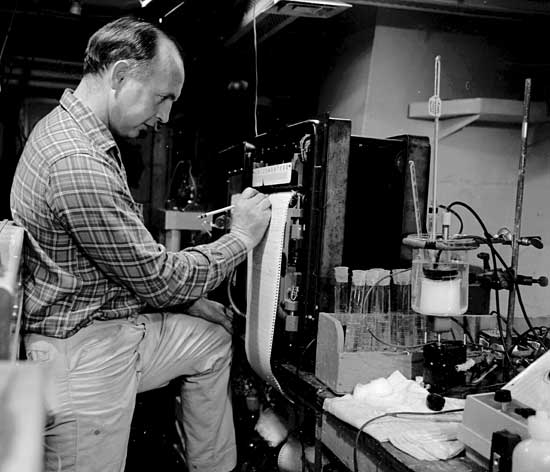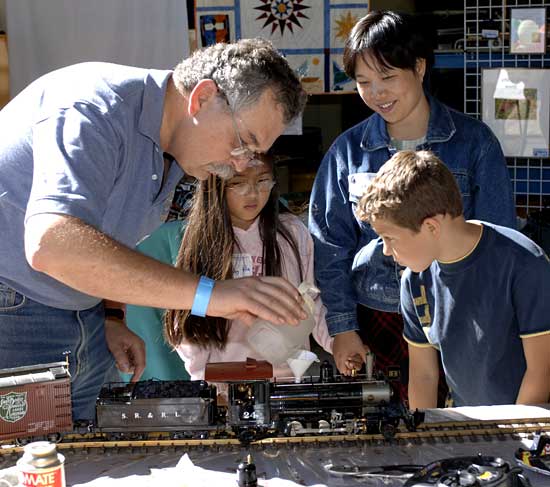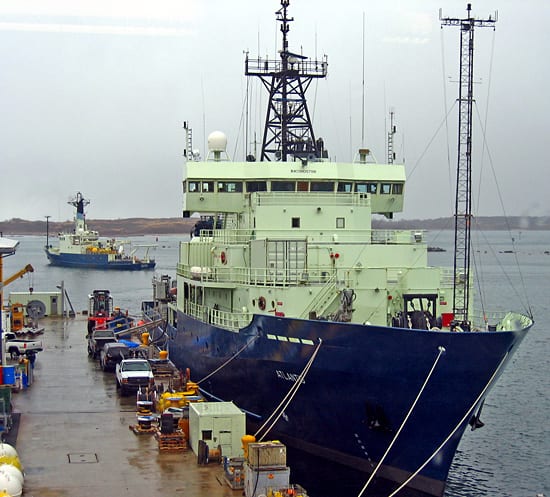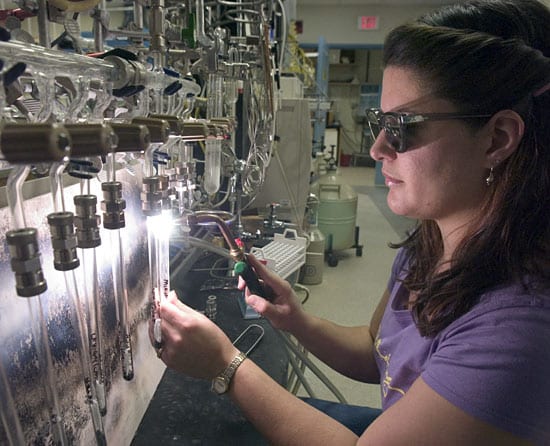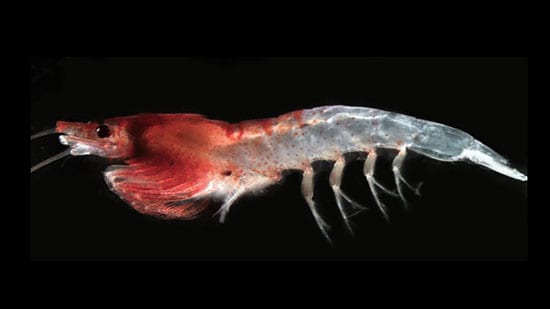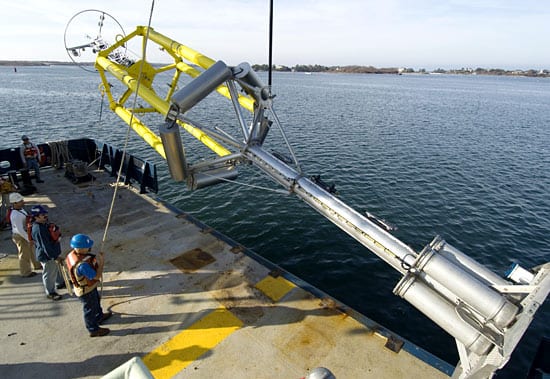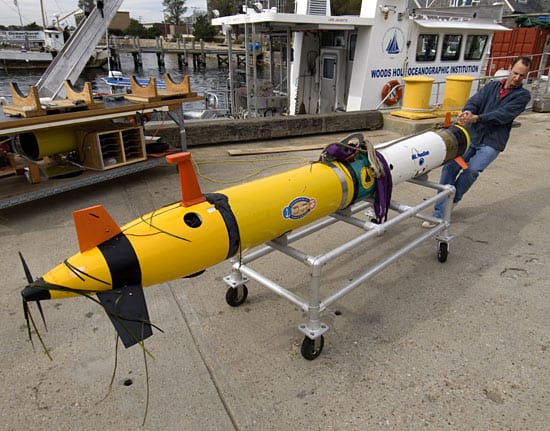Multimedia
It’s All in the Image
Marine biologist Michael Moore and CT Technician Julie Arruda discuss CT images of a marine mammal with students. A new necropsy and scanner facility enhance the team’s ability to handle…
Read MoreConnect the Dots
Polyps of the star coral, montrastrea cavernosa, with a green algae at its center, used as a source of food. Star coral are common in the tropical Atlantic Ocean and…
Read MoreStop!
Research vessel Atlantis Bosun Wayne Bailey signals to a crew member during ship operations for the Galápagos Rift Expedition in May and June 2005. Crew members work closely with scientists…
Read MorePiece by Piece
Early image of the catamaran Lulu, the first support ship for the submersible Alvin (in foreground), circa 1964. The 105-foot Lulu was built in Woods Hole from surplus minesweeping pontoons and…
Read MoreAll in a Day’s Work
The submersible Alvin surfaces after a dive as support vessel Atlantis moves into position for recovery. A typical dive is 8-10 hours. Alvin has made more than 5,000 dives since…
Read MoreFollow That Fin
WHOI biologist Mark Baumgartner enters data from a variety of ocean instruments and tools into his laptop during a 2005 cruise off Cape Cod to investigate where and how whales…
Read MoreBeautiful but Dangerous
Physalia physalis, commonly known as the Portuguese man-of-war or bluebottle, lives in warm waters worldwide and is famous for its painful stinging tentacles up to 50 meters (165 feet) long.…
Read MoreOver and Under
A late-summer iceberg, sculpted by wind and waves into an ice bridge, drifts in the Lemaire Channel on the west coast of the Antarctic peninsula. (Photo by Katherine Madin, Woods…
Read MoreResearch Vessel Chain
R/V Chain sailed in the WHOI fleet from 1958 to 1975, when it was retired. Formerly a Navy salvage ship during World War II, Chain was converted in 1958 for oceanographic research.…
Read MoreSign Here, Please
A steel worker signs a ceremonial construction beam for one of the new laboratories on WHOI’s Quissett Campus. State-of-the-art laboratory facilities formarine research and biogeochemistry were completed in late 2005. (Photo…
Read MoreTaking A Closer Look
MIT/WHOI Joint Program student Mea Cook images a sediment core with an X-ray. (Photo by Tom Kleindinst, Woods Hole Oceanographic Institution)
Read MoreWhat’s in a Shell?
A thin section of a quahog shell reveals annual growth bands, like tree rings, which are valuable for climate change studies. (Photo by Tom Kleindinst, Woods Hole Oceanographic Institution)
Read MorePoolside Science
2005 Summer Student Fellow Derek Cavatorta works on a laptop in front of a test tank, where different types of rope are being tested to help disentangle right whales from fishing gear. (Photo…
Read MoreAwash
Al Plueddemann and Glen Gawarkiewicz prepare to launch REMUS, an autonomous underwater vehicle, from R/V Tioga during a survey in shallow water off Chatham, Mass., in early 2006. (Photo by…
Read MoreHow Does an Observatory Work?
Sensors at mid-ocean ridges detect lava flows, ground motion, and vent chemicals, sending data to shore for real-time research and robotic exploration.
Read MoreOne in a Million
This specimen of Athorybia, a siphonophore or colonial jellyfish, was collected recently from a Census of Marine Zooplankton cruise off the U.S. East Coast. Researchers found many new species in water…
Read MoreSampling at Sea, 1961
WHOI Microbiologist Stanley W. Watson monitors the oxygen uptake of microbes in a seawater sample during an R/V Chain cruise in 1961. (Photo courtesy Woods Hole Oceanographic Institution Archives)
Read MoreAll Aboard!
Physical oceanographer Ken Brink demonstrated his model trains as part of the employee arts and crafts exhibit at the Institution’s 75th anniversary celebration on October 1, 2005. Events celebrating the…
Read MoreA Busy Day in Port
WHOI’s R/V Oceanus leaves port while the R/V Atlantis prepares for its next cruise. The large tower on the bow of each vessel collects meteorological data. (Photo by Amy Kukulya,…
Read MoreMighty Microorganism
Tiny species like this Euphausid photographed in a drop of water are prey to larger organisms in the oceanic food chain. About the size of a fingernail, the shrimp-like creature…
Read MorePieces of a Pirate Ship
Mary Lardie prepares samples from the 18th century pirate ship Queen Anne’s Revenge for carbon dating at the National Ocean Sciences Accelerator Mass Spectrometry facility. Remains of Blackbeard’s flagship were…
Read MoreZooplankton
A Big Buoy
A SPAR buoy is tested off the WHOI dock before loading onto R/V Atlantis. Built in the WHOI shops, the buoy is the largest object beside the submersible ALVIN to…
Read MoreMan with a Mission
Greg Packard prepares an autonomous underwater vehicle (AUV) REMUS equipped with synthetic aperture sonar for testing off the WHOI dock. Different sensors can be added to REMUS depending on the…
Read More
